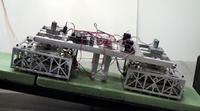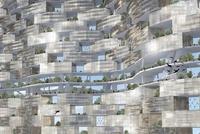-
Next-gen weather satellites to improve tornado warnings in South
More than a quarter of the 1,688 twisters confirmed across the United States in 2011 occurred in the four-state region of Alabama, Georgia, Mississippi, and Tennessee – and most of the 73 tornadoes hitting the United States in January 2012 occurred in those four states; southern tornadoes are especially insidious and challenging to track, and NASA’s weather satellites are now paying special attention to them
-
-
Energy from differences between salt- and fresh water – produced inland
Production of energy from the difference between salt water and fresh water is most convenient near the oceans, but now, using an ammonium bicarbonate salt solution, researchers can combine bacterial degradation of waste water with energy extracted from the salt-water fresh-water gradient to produce power anywhere
-
-
What U.S. can learn from EU chemicals law
U.S. industry and environmental groups agree that the Toxic Substances Control Act of 1976 needs to be modernized better to protect public health and the environment; there is no consensus, however, on what the reform should look like; researchers suggest that the United States may want to look at how the EU regulates chemicals
-
-
Snake-emulating search-and-rescue robot

An all-terrain robot for search-and-rescue missions must be flexible enough to move over uneven surfaces, yet not so big that it is restricted from tight spaces; it might also be required to climb slopes of varying inclines; researchers say the solution would be a search-and-rescue robot which emulates the locomotion of a certain type of flexible, efficient animals: snakes
-
-
Asteroid 2011 AG5 worries to be justified – or not -- in February 2023
Asteroid 2011 AG5 is one of 8,744 near-Earth objects that have been discovered; it is approximately 460 feet (140 meters) in size; it is on a collision course with Earth for 5 February 2040 – but we will k now for sure in February of 2023, when it will pass Earth no closer than about one million miles, making it possible for scientists to plot its future trajectory
-
-
Researchers develop record-breaking plastic solar cell
Researchers at the University of California, Los Angeles (UCLA) have made a breakthrough with plastic solar cells, creating a record-breaking polymer cell that converts 10.6 percent of the sun’s energy into electricity
-
-
Robots to climb and assemble structures, making construction safer

In the near future, armies of robots could nimbly be crawling up towers and skyscrapers to make repairs, so humans do not have to; the design of the truss pieces, which have ridges and specially designed locks so the robot can manipulate them, is as important as the robot itself, and researchers express the hopes that in the future such robot-friendly building components would be standardized for widespread use
-
-
Physicists predict when brittle materials fail
It does not happen often, but structures like bridges, airplanes, and buildings do fail, sometimes catastrophically; what are the odds, and how can it be prevented? Researchers just published new theoretical insights into the probability of structural failures, based on hundreds of thousands of computer simulations
-
-
Detecting explosives from a distance with laser beams
Scientists have found a way to detect chemicals over long distances, even if they are enclosed in containers; the scientists tested the system by trying to detect frequently used explosives, such as TNT, ANFO, or RDX from a distance – and the tests were successful
-
-
Anthrax-decontamination foam used in meth lab cleanup
The meth cleanup problem in the United States is a big one; the U.S. Drug Enforcement Administration lists thousands of locations where law enforcement agencies have found chemicals or paraphernalia indicating the presence of either clandestine drug laboratories or dumpsites; Sandia’s decontamination foam, originally developed to deal with anthrax, is now also a meth eraser
-
-
Future aircraft could capture, re-use some of their own power
When an Airbus 320 lands, a combination of its weight and speed gives it around three megawatts peak available power; researchers work on making the aircraft of tomorrow contribute to their power needs by harnessing energy from the wheel rotation of their landing gear to generate electricity
-
-
Wireless bicycle brake to be shown in Cebit 2012

Scientists have developed a wireless bicycle brake; to brake with the wireless brake, a cyclist needs only clench the rubber grip on the right handle; the scientists say the brake has such a high reliability, only three out of one billion braking attempts will fail; “That is not perfect, but acceptable,” says one of the researchers
-
-
Cell phone-based sensor detects E. coli
Researchers have developed a new cell phone-based fluorescent imaging and sensing platform that can detect the presence of the bacterium Escherichia coli in food and water
-
-
U.S. water shortages loom

More than 1 in 3 counties in the United States could face a “high” or “extreme” risk of water shortages due to climate change by the middle of the twenty-first century; 7 in 10 of the more than 3,100 U.S. counties could face “some” risk of shortages of fresh water for drinking, farming, and other uses
-
-
New app to help fight nonnative species invasion of U.S.
Nonnative species invading the United States — animals, pathogens, and plants — deplete water supplies, poison wildlife and livestock, and damage property in urban and rural areas at a cost of about $138 billion annually; the U.S. Forest Service funded the development of an iPhone application that helps people identify harmful, non-native plants
-
More headlines
The long view
New Technology is Keeping the Skies Safe
DHS S&T Baggage, Cargo, and People Screening (BCP) Program develops state-of-the-art screening solutions to help secure airspace, communities, and borders
Factories First: Winning the Drone War Before It Starts
Wars are won by factories before they are won on the battlefield,Martin C. Feldmann writes, noting that the United States lacks the manufacturing depth for the coming drone age. Rectifying this situation “will take far more than procurement tweaks,” Feldmann writes. “It demands a national-level, wartime-scale industrial mobilization.”
How Artificial General Intelligence Could Affect the Rise and Fall of Nations
Visions for potential AGI futures: A new report from RAND aims to stimulate thinking among policymakers about possible impacts of the development of artificial general intelligence (AGI) on geopolitics and the world order.
Smaller Nuclear Reactors Spark Renewed Interest in a Once-Shunned Energy Source
In the past two years, half the states have taken action to promote nuclear power, from creating nuclear task forces to integrating nuclear into long-term energy plans.
Keeping the Lights on with Nuclear Waste: Radiochemistry Transforms Nuclear Waste into Strategic Materials
How UNLV radiochemistry is pioneering the future of energy in the Southwest by salvaging strategic materials from nuclear dumps –and making it safe.
Model Predicts Long-Term Effects of Nuclear Waste on Underground Disposal Systems
The simulations matched results from an underground lab experiment in Switzerland, suggesting modeling could be used to validate the safety of nuclear disposal sites.
